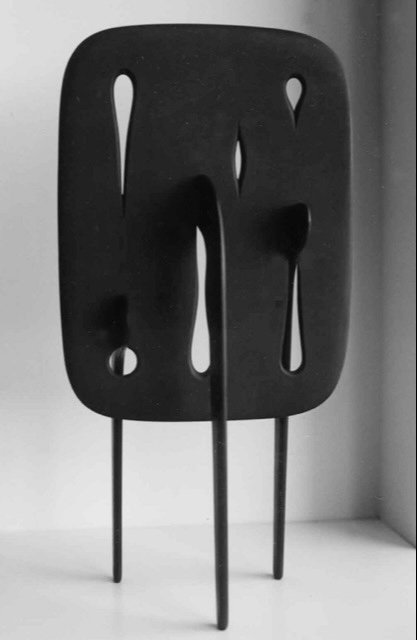The Noguchi is Sold
Mara Kurtz
Word Count 770
When my mother moved into a nursing home in 1995, I had to make all the decisions about my parents’ treasured possessions. Finally, all that remained was their small art collection. After keeping the few pieces I liked, I sold all but one.
I didn’t have the heart to sell my father’s treasure, a small black slate sculpture by the Japanese artist Isamu Noguchi which had been sitting in a drawer under my bed for years, wrapped in yellowed pages from an old New York Times
My father and Noguchi became friends in the 1940’s when my father worked for an advertising agency creating ads for a furniture company’s most popular piece, a curved glass and wood table designed by the young Noguchi.
One day, visiting the studio, my father became enamored with a small black slate rectangle sitting on three curved, moveable legs. Noguchi sold it to him for $100. The piece took center stage wherever we lived throughout my young life.
When my husband and I were planning our annual trip to England in the spring of 2001 we’d been having financial difficulties. We both lived for these vacations, loving everything British, planning each detail throughout the year. I wondered whether our vacations would have to come to an end. For the first time, I started to think it might be time to sell the Noguchi. By now he had become world famous and, of course, the value of his work had grown significantly.
Although I felt torn, it occurred to me that while my father loved the Noguchi, I’d never displayed it, because of my cats, and probably never would.
I called Sotheby’s and Christie’s to discuss possible auctions. When the Sotheby’s specialist came to my apartment he told me the piece was the prototype for an extremely valuable Noguchi at the Chicago Art Institute. It seemed remarkable to him that no one even knew it existed. Then he asked if I could prove its authenticity. I handed him a small grey Kodak folder holding a faded black and white photograph with a deckle edge showing me as a little girl in our living room with my father, playing with the Noguchi on a table between us. That was good enough for him.
Because of a price fixing scandal involving both Sotheby’s and Christie’s at the time, I decided to ask a family friend who owned a prestigious Soho gallery to handle the sale. She said it might take up to a year to find the right buyer but assured me it would sell for an excellent price. Arriving at the gallery with the piece in my arms, still wrapped in the New York Times, I thought about my father and almost changed my mind.
When we arrived in London I headed for the sprawling book floor in Harrods. I searched for maps and books about Cornwall where were planning to spend a week. After a few minutes, a British woman nearby turned to me and said “it appears that you happen to be going to Cornwall.” After a brief conversation, she raved about a book called “The Shell Seekers,” by Rosamund Pilcher, noting that most of the story took place just a few miles from our Cornwall village. She insisted I buy it immediately to begin reading on our five-hour train ride the following day.
I found it a remarkable coincidence that the focus of the book was a painting made by the main character’s father, a famous artist. Because of the value of his work at the time, and her limited financial circumstances, her children urged her to sell his most important and valuable piece, The Shell Seekers. She resists because the painting has so much sentimental meaning for her and tells them “no amount of money can compensate for simply having it in my home.”
Increasingly disturbed as I read the book, I began to have a strong feeling that selling the Noguchi would be a terrible mistake. I kept thinking about the little photographs with my father in our living room and made up my mind to take the Noguchi back as soon as we returned. Two days before we were to leave Cornwall I stopped at a little café in the center of our village which rented computers by the hour. Concerned about my mother’s health, I wanted to see if there was any news from the nursing home. What I found instead was an email from the art dealer in New York. I sat there for a long time, afraid to open it.
Finally, I read the message.
“The Noguchi is sold.”
*
Mara is a graphic designer, photographer and illustrator and founder of Mara Kurtz Studio.
Her work has been published in numerous publications including Metropolis, New York Times Magazine, New York Magazine, Conde Nast Traveler, Travel and Leisure, and The Wall Street Journal.
She has been a Professor at Parsons School of Design,The New School, NYU and School of Visual Arts since 1990. She is a graduate of New York University and Parsons School of Design. She received an MA from The New School in 1995.
The Rock Hill Pictures, a book of Mara's documentary photographs, was published in 2012.
